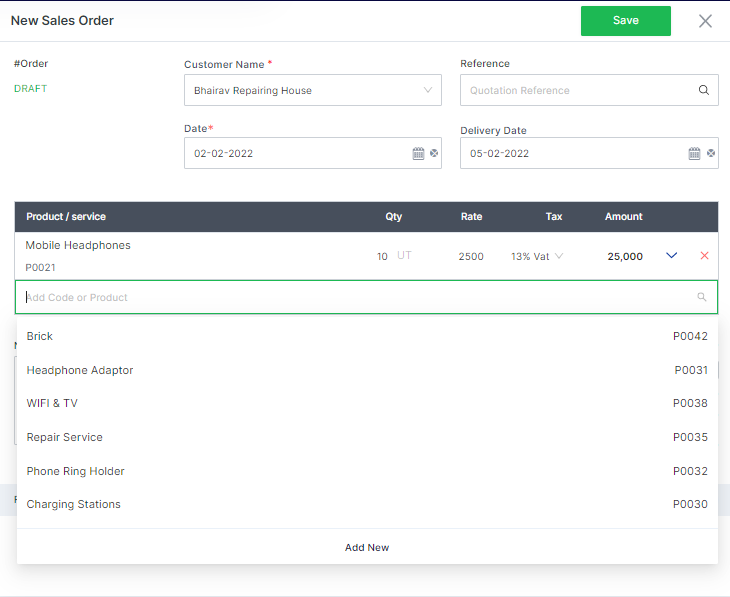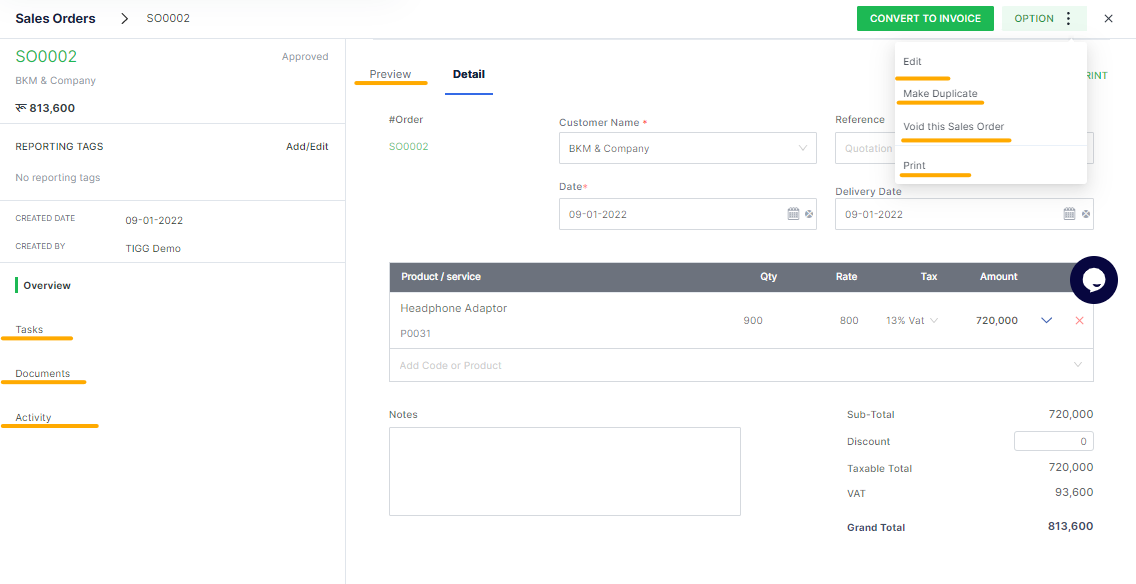Sales Order
A sales order is a document generated by the seller either upon the acceptance of a quotation or receiving a purchase order from the customer.
Shyam
Last Update 3 jaar geleden
A sales order is a document generated by the seller either upon the acceptance of a quotation or receiving a purchase order from the customer. The sales order states the customer information, the details about the product or service, price, quantity, details of the shipment, mode of payment, note to the customer, etc.
In the Sales Order, you can create a new sales order, view, edit and approve the draft sales order, or convert the approved sales order into “Invoice”.
Essential Requirement
To create and use the sales order, it is essential and advisable to create the following
- Customer Name
- Product/Service
How to create a new sales order

- In the Sales Module, Select Sales Order.
- Click on “+Add New” to create a new sales order.
- Unique sales order numbers will be generated automatically if set to auto in configuration or fill manually if set to manual.
- Upon clicking the “Customer Name” field, a drop-down list will appear for the existing customers. Select the desired customer name from the list or type in the name manually. If the desired customer name is not previously created, click on the “Add New” option and fill in the details to create the customer.
- In the “Reference” field, it is optional to type in the relevant information for future reference related to the particular sales order or click on the search icon to list pending quotations of the selected customer to convert into a sales order.
- Select the desired date in the “Date” from the pre-designed calendar by clicking on the calendar icon or clicking on “Today” for the current date.
- Select the “Delivery Date” on which the product/service will be delivered.
- Select the product/service from the list. If the item is previously not created, click on “Add New” to create a new item.
- Enter quantity, rate and select the tax rate. Click on the arrow key next to the amount to provide an additional description for the individual item or click on the delete icon to remove the product from the list.
- If the sales order is created based on a previously created quotation, then click on the search icon to choose the relevant quotation. If the previously created quotation is selected then the product, quantity, rate, tax and discount amount will be populated automatically
- You can provide notes to customers, reporting tags and custom fields.
- Click on the “Save” icon. Click on the desired action from the pop-up box or click elsewhere to save the sales order as a draft. If saved as a draft, you can approve the purchase order from the draft tab.
- Click on the “Reset” icon to clear all the fields and start again.
Options in sales order

When a selected sales order is opened, options can be used to edit, make duplicates, void, print the selected sales order.
Quick Action Button: For the draft sales order, the quick action to “Approve” will be suggested which will convert the draft sales order into an approved sales order. If the approved sales order is selected then the quick action to “ Convert to Invoice” will be suggested.
Edit Sales order– in this option, you can edit the previously created sales order.
Make Duplicate – if you select this option, a replica of the currently displayed sales order will be created as a new sales order. You can however still edit the details/information and save it as a new sales order.
Void this Sales Order – This option nullifies/invalidates the currently selected sales order. Once a transaction is voided such transaction cannot be reverted later.
Preview/PDF/Print: For any document opened, may it be draft or approved, you can preview, print or save as pdf. Tigg offers a pre-designed template for the user, however, you can design/change the templates from “Configuration” in “Printing Templates”.
Field & Description
| Field | Description |
| #Order | Sales Order Number |
| Customer Name* | The custom for whom the Sales Order is to be created |
| Reference | Quotation no or any Reference |
| Date | Date of Sales Order |
| Delivery Date | The expected delivery date of products |
| Product/ Service | Product and services to be sold |
| Quantity | Quantity to be Sold |
| Rate | Product Selling Rate before the discount |
| Discount (Inline) | Discount amount in the product level (item wise) |
| Tax | Choose VAT Applicable |
| Amount | Product value for quoted quantity (item wise) |
| Subtotal | Total without VAT after item discount |
| Discount (Transaction Level) | Discount amount at the Transaction level |
| Taxable Total | Total of the taxable product after transaction-level discount |
| VAT | Amount of VAT |
| Grand Total | Transaction total including VAT |
| Note to Customer | Note visible to the customer |

